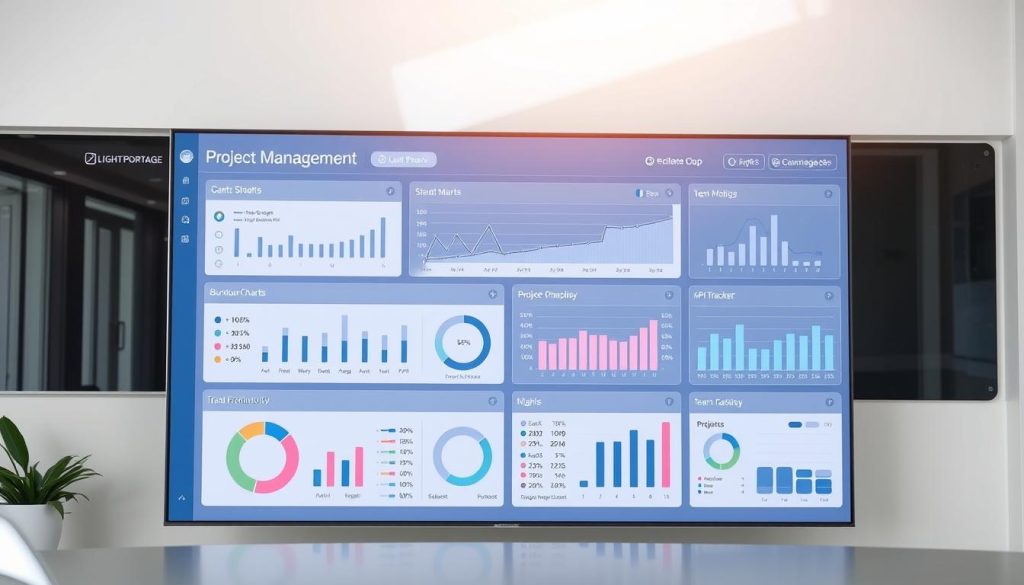As an independent professional, managing your work effectively is crucial for achieving stability and security in your career. The uncertainty of freelance work can be daunting, but with the right project management strategies, you can create a structured and predictable workflow.
Mastering project management principles can transform your independent practice from reactive to proactive, enabling you to deliver high-quality results and foster sustainable income streams. By implementing proper frameworks, you can reduce stress, improve profitability, and achieve a better work-life balance.
Effective management of your projects allows you to optimize resource allocation, meet client objectives, and grow your business sustainably. In this comprehensive guide, we will explore practical strategies tailored specifically for independent professionals like you.
Table of Contents
Key Takeaways
- Understand the fundamentals of project management and its application to independent professionals.
- Learn how to structure your work for maximum efficiency and predictability.
- Discover strategies for reducing stress and improving profitability.
- Explore frameworks for achieving a better work-life balance.
- Gain insights into optimizing resource allocation for sustainable growth.
Understanding Project Management for Independent Professionals
For independent professionals, mastering project management is crucial for achieving stability in their careers. The most successful companies know how to manage a project to remain efficient and productive. Project management provides the leadership, motivation, and problem-solving that enable teams to introduce new products or services, grow revenue, and meet company goals.
The Unique Challenges of Solo Project Management
Solo practitioners face distinct challenges, including managing multiple projects simultaneously, maintaining client satisfaction, and ensuring financial stability. Without a project plan, it’s easy to become overwhelmed by the demands of running an independent practice. The lack of a structured approach can lead to scope creep, missed deadlines, and an uneven workload.
How Project Management Creates Stability
Project management creates stability for independent professionals in several ways. It establishes predictable workflows that clients can rely on, leading to increased trust and repeat business. Financial stability emerges from proper project planning through accurate estimating, scope control, and effective resource allocation. By implementing structured management tools and processes, independent professionals can reduce the cognitive load of constantly reinventing approaches, allowing them to focus their creative energy on client deliverables.
By creating clear boundaries between projects, independent professionals can better manage client expectations and reduce the stress of competing priorities that often leads to burnout. Effective project management enables independent professionals to transform chaotic freelance work into a sustainable, scalable practice with greater income security.
The Fundamentals of Project Management
For independent professionals, mastering project management basics is key to ensuring successful project outcomes and long-term stability. Effective project management enables solo practitioners to deliver quality work, meet client expectations, and maintain a competitive edge in their respective markets.
Key Project Management Concepts
Understanding key project management concepts is essential for independent professionals. These concepts include scope definition, resource allocation, and stakeholder identification. By grasping these fundamentals, solo practitioners can better manage their projects and improve client satisfaction.
Some critical aspects of project management include:
- Defining project scope and objectives
- Identifying and allocating necessary resources
- Managing stakeholder expectations
- Utilizing management software to streamline processes
The Project Life Cycle
The project life cycle consists of five process groups: Initiating, Planning, Executing, Monitoring and Controlling, and Closing. Each phase is crucial for the successful completion of a project.
During the initiation phase, independent professionals establish the project’s foundation, including scope definition and stakeholder identification. The planning phase is critical for reducing the risk of scope creep and resource overallocation. Execution, monitoring, and controlling phases often overlap, requiring efficient systems for visibility. Finally, the closing phase presents opportunities for strengthening client relationships and securing future work.
Setting Up Your Project Management System
As an independent professional, setting up a tailored project management system can significantly enhance your productivity and client satisfaction. By establishing a structured framework, you can efficiently manage your projects and maintain a competitive edge in your field.
Assessing Your Project Management Needs
To create an effective project management system, you must first assess your specific needs. This involves evaluating your current workflow, identifying areas of inefficiency, and determining the requirements for your projects. By understanding your needs, you can develop a system that is tailored to your business, enhancing your ability to deliver projects successfully.
Creating a Scalable Framework
A scalable framework is crucial for managing projects as your business grows. This framework should include processes for project planning, task management, and team collaboration (even if you’re working solo, you may collaborate with other professionals or clients). By having a scalable framework, you can adapt to changing project demands and expand your business without compromising on quality.
Establishing Standard Operating Procedures
Standard Operating Procedures (SOPs) are essential for maintaining consistency and efficiency in your project management system. SOPs help reduce decision fatigue, ensure quality across client engagements, and streamline processes such as client onboarding, project kickoff, and communication protocols. By documenting these procedures, you can ensure that critical steps are not missed, even when managing multiple projects concurrently.
- Developing clear client onboarding procedures to establish professional expectations from the beginning.
- Creating standardized project kickoff, check-in, and closeout processes to ensure critical steps are not missed.
- Documenting communication protocols for different situations to provide clarity for both you and your clients.
Project Management Methodologies for Independent Professionals
Independent professionals must navigate various project management methodologies to find what works best for their unique needs. The right methodology can help manage projects efficiently, ensuring they meet client expectations and are completed on time.
Agile Project Management
Agile project management is a flexible and adaptive approach that is particularly beneficial for projects with changing requirements. It emphasizes iterative progress, collaboration, and customer feedback. For freelancers, Agile can be tailored to suit the dynamic nature of their projects.
Key benefits: Flexibility, iterative progress, and customer collaboration.
Waterfall Methodology
The Waterfall methodology is a more traditional, linear approach to project management. It is characterized by a sequential design process where each phase must be completed before moving on to the next. This methodology is suitable for projects with well-defined requirements and a clear understanding of the project’s scope.
Advantages: Clear structure, easy to manage, and straightforward to understand.
Kanban for Solo Practitioners
Kanban is a visual system for managing work, emphasizing continuous flow and limiting work in progress. For solo practitioners, Kanban can help in managing multiple projects by visualizing tasks and workflows, thus enhancing productivity.
Hybrid Approaches
Hybrid project management approaches allow independent professionals to combine elements from different methodologies based on specific project requirements. For instance, using Waterfall planning with Agile execution can balance structure with flexibility. This adaptability is crucial for managing diverse projects and client preferences.
Hybrid approach benefits:
- Combining Waterfall planning with Agile execution for complex projects.
- Integrating Kanban visualization with traditional milestone tracking.
- Adapting project management styles to different client needs without separate systems.
Essential Project Management Tools
In the realm of project management for independent professionals, the choice of tools can significantly impact productivity and client satisfaction. To manage projects effectively, it’s essential to have the right set of tools.
For more insights on managing projects and teams, you can visit our blog on how to find freelancers for your.
Project Management Software Options
Selecting the right project management software is critical. Options like Trello, Asana, and Basecamp offer various features tailored to the needs of independent professionals.
Time Tracking and Productivity Tools
Time tracking and productivity tools help independent professionals manage their time more efficiently. Tools like Harvest and Toggl enable accurate time tracking, while RescueTime provides insights into productivity patterns.
Communication and Collaboration Platforms
Effective communication is vital for project success. Platforms like Slack for chat, Zoom for virtual meetings, and Google Drive for file sharing facilitate seamless collaboration between independent professionals and their clients.
Project Planning and Scope Management
The foundation of successful project management lies in meticulous planning and clear scope management. For independent professionals, this means establishing a robust framework that guides the project’s execution from start to finish.
Defining Clear Project Objectives
Defining clear project objectives is the first step in effective project planning. This involves understanding the client’s needs and expectations and translating them into measurable goals. Clear objectives help in creating a focused project plan and ensure that all stakeholders are aligned.
Creating Detailed Project Plans
Once the objectives are clear, the next step is to create a detailed project plan. This plan should outline the tasks, timelines, and resources required to achieve the project objectives. Effective project planning involves breaking down the project into manageable tasks and establishing a timeline for their completion.
| Project Plan Component | Description | Importance |
|---|---|---|
| Project Objectives | Clear definition of what the project aims to achieve | High |
| Task List | Detailed list of tasks required to complete the project | High |
| Timeline | Schedule for completing the tasks | Medium |
| Resource Allocation | Assignment of resources (time, money, personnel) to tasks | High |
Preventing Scope Creep
Scope creep is a common challenge in project management, where the project’s scope expands beyond the original agreement. To prevent this, independent professionals must establish clear change management processes at the project’s initiation. This includes documenting out-of-scope requests and their implications, and conducting regular scope reviews.
- Establish clear change management processes
- Document out-of-scope requests with associated time and cost implications
- Conduct regular scope reviews during project execution
Time Management Strategies for Independent Professionals
Time management is a critical skill that independent professionals must master to achieve stability and growth. As solo practitioners, they face unique challenges in managing their time effectively, given the absence of a structured team environment.
Effective time management enables independent professionals to deliver projects on time, maintain client satisfaction, and ensure their business remains profitable. To achieve this, they must adopt strategies that help them estimate project timelines accurately and meet deadlines consistently.
Estimating Project Timelines Accurately
Accurate project timeline estimation is crucial for independent professionals to manage client expectations and plan their work efficiently. To achieve this, they can use time tracking and timesheets to log hours worked and track time spent on tasks. This data helps in creating more accurate estimates for future projects.
- Break down the project into smaller, manageable tasks to estimate the time required for each task.
- Use historical data from previous projects to inform the estimation process.
- Include buffer time in the project timeline to account for unexpected delays or challenges.
Techniques for Meeting Deadlines Consistently
Meeting deadlines consistently is vital for building client trust and maintaining a professional reputation. Independent professionals can use various techniques to achieve this, such as time blocking to protect focused work time from interruptions.
- Implement personal accountability systems to compensate for the lack of team structure.
- Use productivity methodologies like Pomodoro, time blocking, and task batching to enhance work efficiency.
- Create interim milestones with buffer time before final deadlines to identify potential delays early.
Budget Management and Financial Stability

Budget management plays a pivotal role in the financial stability of solo practitioners. Effective budget management enables independent professionals to track expenses, manage project budgets, and ensure profitability.
Project Budgeting Fundamentals
Establishing a comprehensive budget is the foundation of successful project management. This involves identifying all potential costs, including labor, materials, and overheads. Project-based accounting practices help in understanding the true profitability of each project. By doing so, independent professionals can make informed decisions about future projects and pricing strategies.
Tracking Expenses and Profitability
Systematic expense tracking is crucial for identifying profitability patterns across different projects and clients. Utilizing budgeting and cost management tools allows for real-time monitoring of expenses against the budget. This enables independent professionals to identify areas of cost overrun and take corrective actions promptly.
| Budgeting Aspect | Importance | Tools/Methods |
|---|---|---|
| Project Budgeting | Ensures financial planning and control | Project management software, Budget templates |
| Expense Tracking | Monitors actual vs. budgeted expenses | Accounting software, Expense tracking apps |
| Profitability Analysis | Helps in understanding project profitability | Financial analysis tools, Project-based accounting |
By implementing these budget management strategies, independent professionals can achieve financial stability and ensure the long-term sustainability of their projects.
Risk Management for Solo Practitioners
To achieve stability in their projects, independent professionals must prioritize risk management. As solo practitioners, they face unique challenges that can impact their project’s success. Effective risk management enables them to identify potential risks, assess their impact, and develop strategies to mitigate them.
Identifying Potential Project Risks
Identifying potential project risks is the first step in managing them. Independent professionals can use risk management tools to identify, assess, and mitigate project risks. Some common risks include project scope changes, delays in payment, and resource unavailability. By understanding these risks, solo practitioners can develop contingency plans to address them.
- Scope creep and changes in project requirements
- Delays in client payments or payment disputes
- Resource constraints or unavailability
Creating Contingency Plans
Creating contingency plans is crucial for managing identified risks. These plans provide predetermined response strategies for common project disruptions, reducing stress and improving response time. Some effective contingency planning strategies include:
- Developing backup resource plans to address resource unavailability
- Creating financial contingencies, such as contract terms and payment schedules, to protect against payment issues
- Establishing client communication templates for various risk scenarios to ensure professional responses
Client Management Within Your Project Framework
For independent professionals, integrating robust client management strategies into their project management framework is essential for long-term success. Effective client management ensures that projects are delivered on time, within budget, and to the client’s satisfaction, thereby enhancing the professional’s reputation and fostering repeat business.
Setting Client Expectations
Establishing clear expectations with clients at the outset of a project is crucial. This involves defining the project scope, timelines, and deliverables. By doing so, independent professionals can manage client expectations and reduce the likelihood of misunderstandings or disputes later on. Clear revision policies should also be established to handle client feedback effectively.
Managing Client Communication
Regular and structured communication is key to successful client management. Independent professionals should implement a communication plan that keeps clients informed about project progress. This can include regular updates, progress reports, and scheduled meetings. By maintaining open lines of communication, professionals can address client concerns promptly and ensure that projects stay on track.
Handling Feedback and Revisions
Client feedback is an essential component of the project management process. Independent professionals should establish a structured process for collecting, documenting, and acting on client feedback. This includes implementing version control systems to manage revisions and ensure that all stakeholders are working with the most current documents. By handling feedback and revisions professionally, professionals can maintain positive client relationships and deliver high-quality outcomes.
Quality Control for Independent Professionals
As independent professionals navigate their project management journey, maintaining quality control becomes a pivotal aspect of their success. Ensuring that projects meet the required standards is crucial for building a strong reputation and maintaining client satisfaction.
Establishing Quality Standards
Establishing clear quality standards is the foundation of effective quality control. Independent professionals should define what constitutes a high-quality outcome for their projects. This involves understanding client expectations, industry benchmarks, and the specific requirements of each project. By setting clear standards, professionals can ensure that their work meets the necessary criteria, reducing the likelihood of rework or client dissatisfaction. Implementing systematic quality assurance processes, such as pre-submission review protocols and checklists, can help achieve this goal.
Quality Assurance Processes
Implementing quality assurance processes is vital for delivering consistent results. Independent professionals can benefit from creating checklists, engaging in peer reviews with trusted colleagues, and analyzing quality-related data across projects to identify areas for improvement. These processes help in maintaining high standards and adapting to changing client needs and industry developments. By focusing on quality assurance, independent professionals can enhance their project management capabilities and achieve long-term success.
Managing Multiple Projects Simultaneously
As an independent professional, the ability to manage multiple projects simultaneously is a key factor in the success of your business. This capability not only enhances your productivity but also contributes to the stability and growth of your professional endeavors. To effectively manage multiple projects, you need to employ strategic planning, efficient resource allocation, and robust prioritization techniques.
Prioritization Techniques
Prioritizing tasks across multiple projects is crucial. Using techniques like the Eisenhower Matrix can help you categorize tasks based on their urgency and importance. This method allows you to focus on critical tasks that drive project progress.
Resource Allocation Across Projects
Effective resource allocation is vital when managing multiple projects. This involves distributing your time, skills, and other resources efficiently across projects. Creating a resource allocation plan helps in identifying the resources required for each project and ensuring that they are available when needed.
Avoiding Burnout While Maximizing Productivity
Managing multiple projects can lead to burnout if not managed properly. Implementing sustainable productivity practices, such as deliberate work/rest cycles, can help maintain your energy levels. Establishing clear boundaries between work and personal time is also essential to prevent the always-on mentality.
| Methodology | Description | Suitability for Multiple Projects |
|---|---|---|
| Agile | Iterative and flexible approach | High |
| Waterfall | Linear and sequential approach | Low |
| Kanban | Visual system for managing work | High |
« The key is not to prioritize what’s on your schedule, but to schedule your priorities. » – Stephen Covey
Documentation and Knowledge Management
Effective project management for independent professionals requires more than just handling tasks; it demands a systematic approach to documentation and knowledge management. This systematic approach enables professionals to maintain consistency across projects and improve over time.
Creating Templates and Reusable Assets
Developing templates and reusable assets is a crucial step in streamlining project management processes. By creating standardized templates for common tasks and documents, independent professionals can save time and ensure consistency across projects. This approach also facilitates the onboarding of new clients or team members, as it provides a clear framework for engagement.
Implementing systematic project retrospectives and establishing categorized reference libraries are practices that contribute to a robust knowledge management system. These practices help in capturing insights and lessons learned, which can be applied to future projects, thereby enhancing overall project management efficiency.
Building Your Professional Knowledge Base
Building a professional knowledge base is essential for independent professionals to stay competitive and deliver high-quality services. This involves creating client-specific knowledge repositories that capture important preferences, history, and context, thereby improving service delivery efficiency. By leveraging these knowledge bases, professionals can tailor their management strategies to meet the unique needs of each client, enhancing overall satisfaction and loyalty.
Moreover, a well-structured knowledge base supports the continuous improvement of project management practices. It allows professionals to reflect on past experiences, identify best practices, and implement changes that drive future success.
Measuring Project Success as an Independent Professional

Independent professionals need to assess their project success to refine their project management strategies. Measuring success is crucial for making informed decisions and ensuring long-term stability in their careers.
Key Performance Indicators
Key Performance Indicators (KPIs) are essential for evaluating the success of projects. As an independent professional, you should track KPIs that are relevant to your projects, such as profitability, client satisfaction, and project completion time. By monitoring these indicators, you can identify areas for improvement in your project management processes.
Using Data to Improve Future Projects
Systematic data collection and analysis across projects enable independent professionals to make evidence-based improvements. By creating project comparison frameworks, you can identify patterns in profitability, efficiency, and client satisfaction. Regular data review practices ensure that insights are applied to future projects, enhancing your project management
By leveraging data effectively, you can refine your project planning, execution, and delivery, ultimately leading to greater success as an independent professional.
Building Long-Term Stability Through Project Management
Establishing a robust project management system is critical for independent professionals to achieve long-term stability and growth. By implementing effective project management practices, solo practitioners can create a solid foundation for their business, enabling them to scale and expand their services.
A key aspect of achieving stability is creating predictable income streams. This can be accomplished by:
- Developing standardized processes and documentation to ensure consistency in project delivery
- Establishing clear project roles and responsibilities to facilitate delegation and teamwork
- Implementing scalable client management approaches to maintain high-quality relationships as the client base grows
Creating Predictable Income Streams
To create predictable income streams, independent professionals must focus on delivering high-quality projects consistently. This involves developing project management systems that ensure timely completion, effective resource allocation, and excellent client communication. By doing so, solo practitioners can build a reputation for reliability and attract repeat business and referrals.
Scaling Your Independent Practice
As independent professionals grow their business, they must be able to scale their project management systems to accommodate increased demand. This requires establishing a robust framework that can be adapted to changing circumstances, leveraging resources efficiently, and maintaining a high level of quality control. By achieving this, solo practitioners can successfully transition from solo practitioners to leaders of a small team, driving business growth and expansion.
Conclusion
In the world of independent professionals, project management serves as the foundation for a stable and scalable business. Effective project management provides the structure and predictability necessary to create stability in an otherwise uncertain freelance environment. By implementing appropriate project management methodologies, tools, and processes, independent professionals can transform chaotic freelance work into a sustainable, scalable independent practice.
Mastering the core project management disciplines covered in this guide enables independent professionals to reduce stress, improve profitability, and achieve a better work-life balance. The investment in developing project management competence yields significant returns through increased client trust, more efficient operations, and the ability to handle higher-value engagements. To achieve this, we encourage independent professionals to begin implementing these approaches incrementally.
- Start by addressing the most significant current pain points.
- Focus on the areas that need improvement first.
- Expand to more comprehensive systems gradually.
By doing so, independent professionals can create a robust project management system that supports their business goals. Using the right tools and software is crucial in this process. As you continue on this journey, remember that project management is a skill that develops over time with practice and patience.
By adopting a structured management approach, you can ensure the long-term stability and success of your independent practice.
FAQ
What are the essential skills required for effective project management as an independent professional?
To manage projects successfully, independent professionals need skills such as time management, budgeting, risk assessment, and communication. These skills help in delivering projects within the stipulated timeline and budget, thereby ensuring client satisfaction and building a strong professional reputation.
How can I determine the most suitable project management methodology for my independent practice?
The choice of project management methodology depends on the nature of your projects, client requirements, and your work style. For instance, Agile is suitable for projects that require flexibility and iterative progress, while Waterfall is better for projects with well-defined requirements and a linear workflow.
What tools are available to help independent professionals manage their projects efficiently?
There are various project management tools available, including software options like Trello, Asana, and Microsoft Project, which offer features such as task management, time tracking, and collaboration. The choice of tool depends on the specific needs of your projects and your personal preference.
How can I manage multiple projects simultaneously without compromising on quality or missing deadlines?
To manage multiple projects, prioritize tasks based on urgency and importance, allocate resources effectively, and utilize project management tools to track progress. Regularly reviewing project status and adjusting plans as needed helps in maintaining quality and meeting deadlines.
What strategies can I use to maintain financial stability as an independent professional?
Strategies for financial stability include creating a budget, tracking expenses, and ensuring timely invoicing. Diversifying your income streams and having a contingency plan for unexpected expenses also contribute to financial stability.
How do I handle scope creep in my projects?
To prevent scope creep, clearly define project objectives and scope at the outset, and establish a process for managing changes. Regular communication with clients and stakeholders helps in managing expectations and minimizing the risk of scope creep.
What are the key performance indicators (KPIs) for measuring project success?
KPIs for measuring project success include metrics such as project completion rate, adherence to budget, client satisfaction, and quality of deliverables. Tracking these KPIs helps in evaluating project performance and identifying areas for improvement.
How can I scale my independent practice through effective project management?
Scaling your practice involves developing a robust project management framework, leveraging technology and tools, and continually improving your processes. By delivering high-quality projects consistently, you can build a strong reputation, attract more clients, and grow your business.





